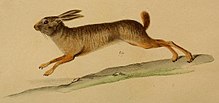
Back Pronolagus Afrikaans قواعات الصخر الأحمر Arabic قواعات الصخر الاحمر ARZ Libol (Pronolagus) AVK Conill roquer Catalan Pronolagus CEB Rotkaninchen German Pronolagus Spanish Pronolagus Basque خرگوش سنگی سرخ Persian
| Pronolagus | |
|---|---|

| |
| Illustration of P. crassicaudatus from Geoffroy, 1832 | |
| Scientific classification | |
| Domain: | Eukaryota |
| Kingdom: | Animalia |
| Phylum: | Chordata |
| Class: | Mammalia |
| Order: | Lagomorpha |
| Family: | Leporidae |
| Genus: | Pronolagus Lyon, 1904[1][2] |
| Type species | |
| Lepus crassicaudatus I. Geoffroy, 1832
| |
| Species | |

| |
P. crassicaudatus range P. randensis range P. rupestris range P. saundersiae range
| |
The red rock hares are the four species in the genus Pronolagus. They are lagomorphs of the family Leporidae living in rocky habitats across Africa. Three species are restricted to Southern Africa, while one—Smith's red rock hare (P. rupestris)—is found as far north as Kenya. The red rock hares are rufous, dark brown, or reddish-brown-tailed rabbits that vary in size, with some shared physical characteristics being short ears and a lack of an interpareital bone. They have 42 chromosomes and are active during the night, feeding only on plants. Breeding results in litters of one to two altricial young.
The red rock hares have a varied taxonomic history. Initially described as members of the genus Lepus or Oryctolagus, the genus Pronolagus was proposed in 1904 to describe a skeleton of Pronolagus crassicaudatus, which was at that time labeled under the genus Lepus. This would become the type species of the red rock hare genus. Since then, of the currently accepted members, two new species have been described as members of Pronolagus—Jameson's red rock hare (P. randensis) and Hewitt's red rock hare (P. saundersiae, originally a subspecies of P. rupestris)—while the third, Smith's red rock hare, was described in 1834 as Lepus rupestris. Two extinct species have been proposed, but one is a nomen oblitum.
All members of Pronolagus are considered least-concern species by the International Union for Conservation of Nature (IUCN), but there are few conservation measures that apply to the red rock hares. Excepting Hewitt's red rock hare, there are seasonal hunting regulations that restrict hunting red rock hares, and various protected areas and national parks intersect the ranges of each species; however, the expansion of commercial plantations has led to habitat loss, and the population of red rock hares is expected to decrease.